




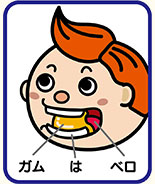









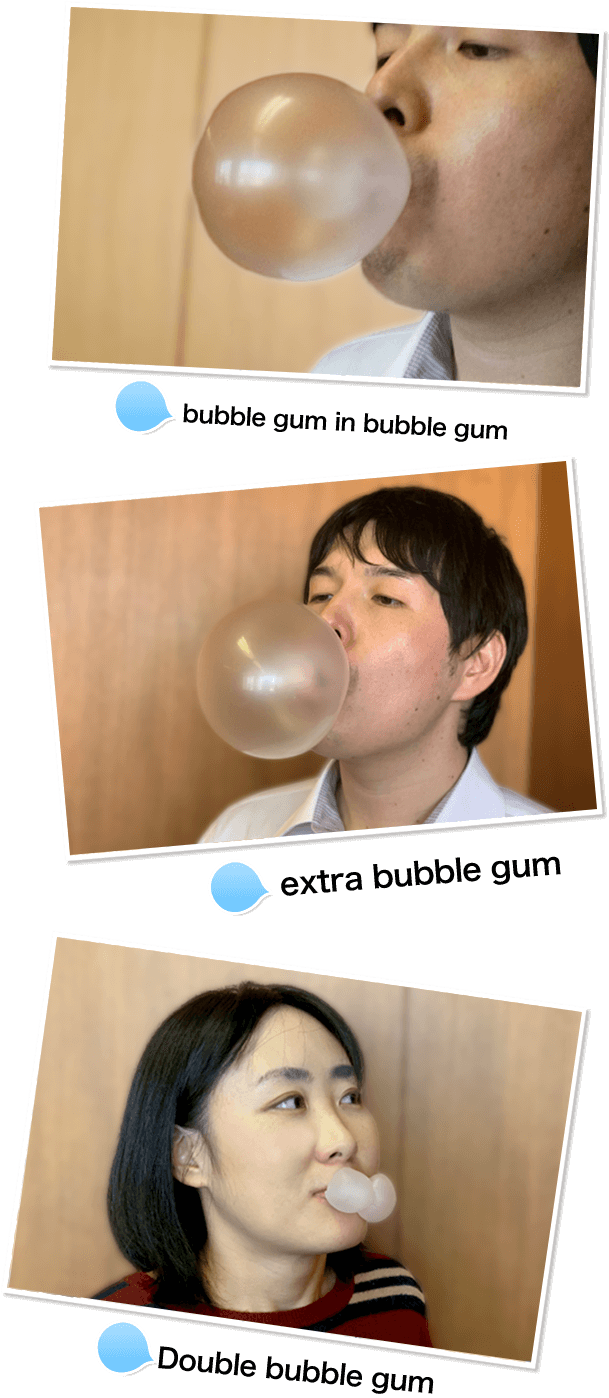
A.D.2010
A.D.2011
A.D.2012
A.D.2013
A.D.2014
A.D.2015
A.D.2016
A.D.2017
A.D.2018
A.D.2019

It was discovered around 800 A.D. The origin can be traced back to the civilizations of the Aztecs and Mayans who inhabited Central America in what is now south Mexico, Guatemala and Honduras. At that time, there were trees called Sapodilla growing in the area and the people had a habit of chewing a substance, extracted from the tree, which was called chicle and is the origin of chewing gum today.

The Mayan's prosperity reached its peak around 800 A.D and then started to decline. In the 16th century (The first rifles "Teppo" were brought to Tanegashima, Japan.) When the Spanish conquered the area, almost all of the Mayans had disappeared. However, their habit of chewing chicle (human's "chewing instinct") continued after the Spanish invaded and spread among the Spanish immigrants.

Around 1860 A.D.(late Edo period) General Santa Anna who gained prominence in the war between America and Mexico came up with the plan to produce rubber made from chicle which was tried without success. However, he was amazed by the wonderful texture, and the benefit of whitening teeth, and started selling candy-like substances made from unsweetened chicle. After his troops supported him he added sugar to the substances and sold them in America where they got especially popular. Some were flavoured with mint as well as cinnamon and widely accepted all over the world.

It was in Taisho 5 (1916) when chewing gum was imported for the first time into Japan and around Showa 3 (1928) companies such as Masaki and Shinkouseika started selling their product domestically. However, at the time it wasn't sold successfully as it wasn't compatible with the Japanese diet. During World War II, chewing gum was included in the food rations of American soldiers. In Showa 20 (1945), at the end of the war, American chewing gum was rapidly accepted by the Japanese as a new fashion and a lot of people adopted it along with the westernization of their lifestyle. Manufacturing process of chewing gum began.



| Sap is collected | Sap is collected from trees that belong to 'Akatetsu' (Sapotaceae) 'Kyoutikutou' (Apocynaceae) 'Kuwa' (Moraceae) and 'Toudaigusa' (Euphorbiaceae) in systemic botany. They grow in Central and South America and south-east Asia and the common sap is chicle.To collect it, carve a v-shape in the trunk at from the bottom to the top and place a container above 1 meter from ground level..This reddish substance when boiled is the plant sap which is the base of chewing gum. |
|---|---|
| Vinyl acetate | Vinyl acetate is a substance that is transparent. Undissolved it is also tasteless and odourless. It was invented in Germany in 1912.When used in chewing gum it must pass the high standards of the Food Safety Authority.This plant sap is the base of chewing gum and makes it softer and gives it excellent texture. It has passed several recognized safety tests. |
| Ester gum | Ester gum It is used for improving the texture. It has passed several recognized safety tests. |
| Polyisobutylen | Polyisobutylen is used for adding elasticity. It has passed several recognized safety tests. |
| Calcium carbonate | Calcium carbonate is used to prevent the chewing gum becoming too soft and breaking down. |
| Sweeteners | Sweeteners: Cane sugar, glucose, and starch syrup are used.These days Maltitol, Xylitol are also used. |
| Softener makes | Softener makes the entire chewing gum soft and gives it a nice texture.Softener is made of water and glycerin and only one that has passed several tests can be used. |
| Flavour | Natural plant essential oil is the core of the flavour. The most popular mint flavours are peppermint (Western mint, Japanese mint) and spar mint(Dutch mint) and each of their plant oils are extracted by steam distillation.Citrus flavour such as lemon and orange are also extracted by steam distillation from fruits. |
| Peppermint | You must think of the taste of chewing gum when you hear "Peppermint". You feel like your mind is refreshed even by only smelling peppermint. This effect has been known for long time ago and is written in The Herb Book of the 16th century. "The smell makes human beings happy". Ever since peppermint flavoured chewing gum was introduced in 1880, it became the primary taste of chewing gum. Even today it is the most popular flavour of chewing gum. |
It is the day to re-think the importance of chewing and was established by the Japan Chewing Gum Association in June, Heisei 6 (1996). We hope many people will think about the importance of chewing, health, and manners in modern times.



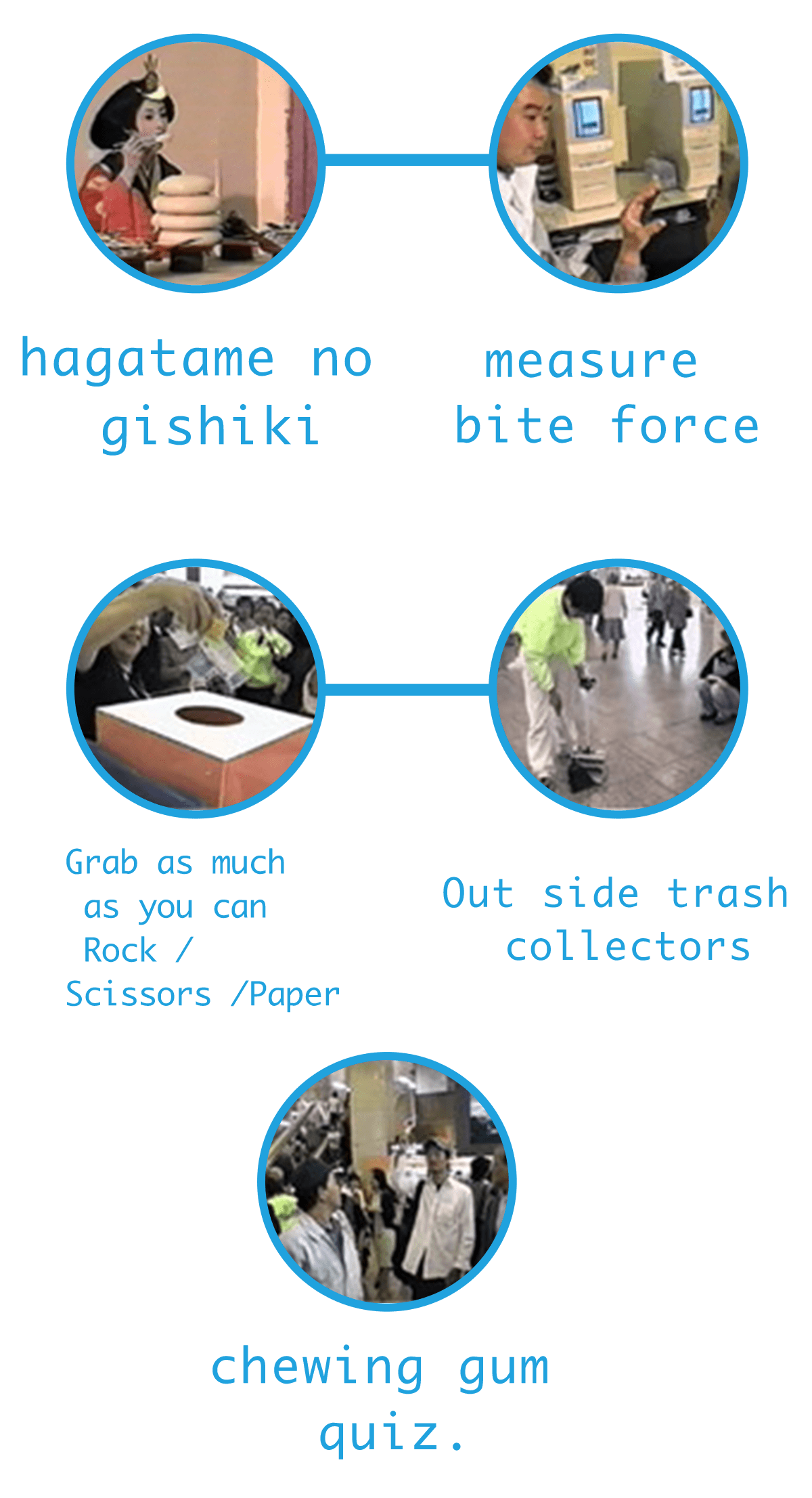
Because of chewing gum's distinct features, it can be combined with a lot of different ingredients and made into various shapes. On top of that, if we count each different flavour and scent the number of products is unlimited.



Apart from these, there are products mixed with chewing gum such as jam, candy, or powder.
Although mint and fruit are the typical taste of chewing gum, there are also spice, coffee and coca cola flavoured chewing gum.
| Mint flavour | peppermint and spearmint |
|---|---|
| Fruit flavour | Orange, lemon, apple, melon, cherry, plum, grape, raspberry, strawberry. |
| Spice flavour | cinnamon, licorice etc.. |
| Others | coffee, coca cola, green tea, black tea, wine. |
There is two core types of sweeteners. One called "Sugar type" which made with cane sugar or glucose sugar the other called "Sugar free type" which is made with maltitol or xylitol.


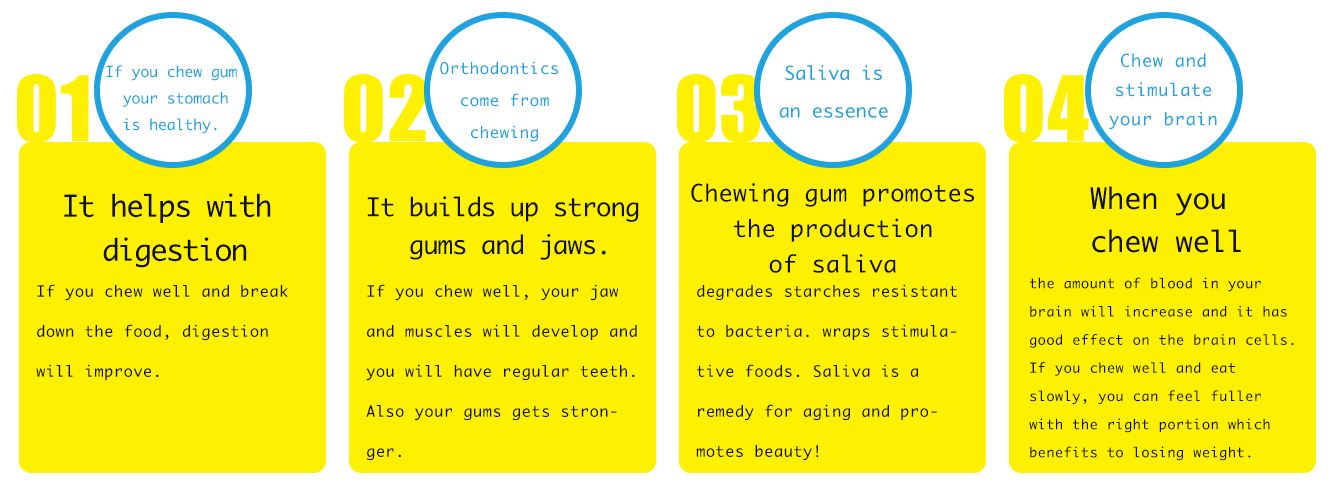

habit of chewing well
secretion of saliva and improved digestion.
anti-aging by secretion hormones.
Activate brain by stimulation.
Improve the efficiency of studying and tasks.
Strengthening roots of teeth
Development of jaw
The research of elementary school students in Kanagawa prefecture revealed that the function of chewing has been dramatically weakened because they tended to eat softer food more often. For the children who had lost the habit of chewing a wide range of food, we strongly suggested the need of prompt improvement to their diet.
Divide students into three groups.
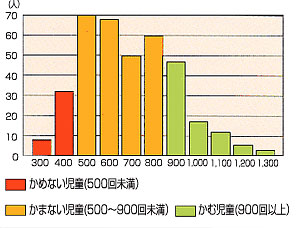
3 out of 4 elementary school students Non-biting, non-biting children
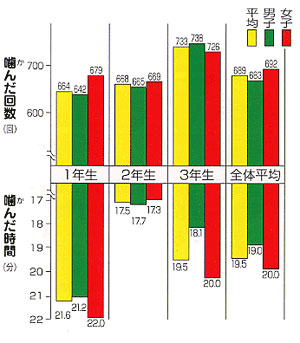
The cause of this is that they tend to wash down food with milk.
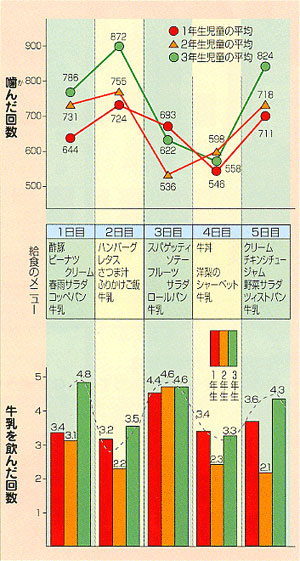
A warning to the jaws of modern human beings. The diet that promotes the importance of chewing has been forgotten. The eating experiment from when Princess Himiko lived until modern times proves that "Chewing" keeps the oral cavity clean and improves the metabolism of teeth and jaw function and also our entire well being.
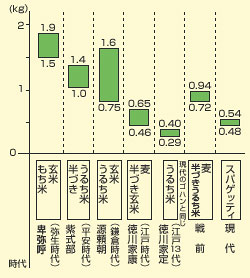
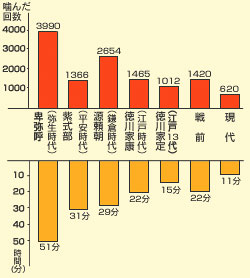
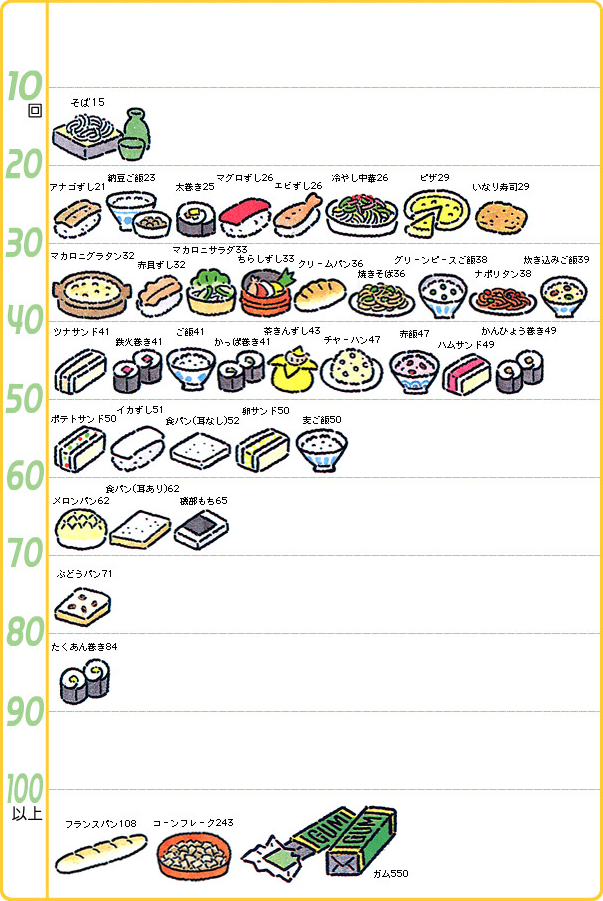

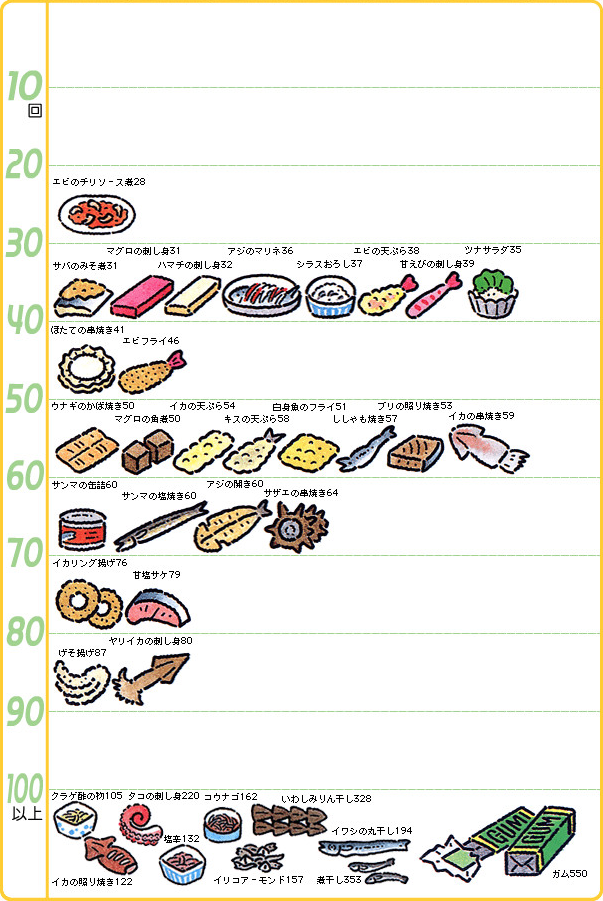

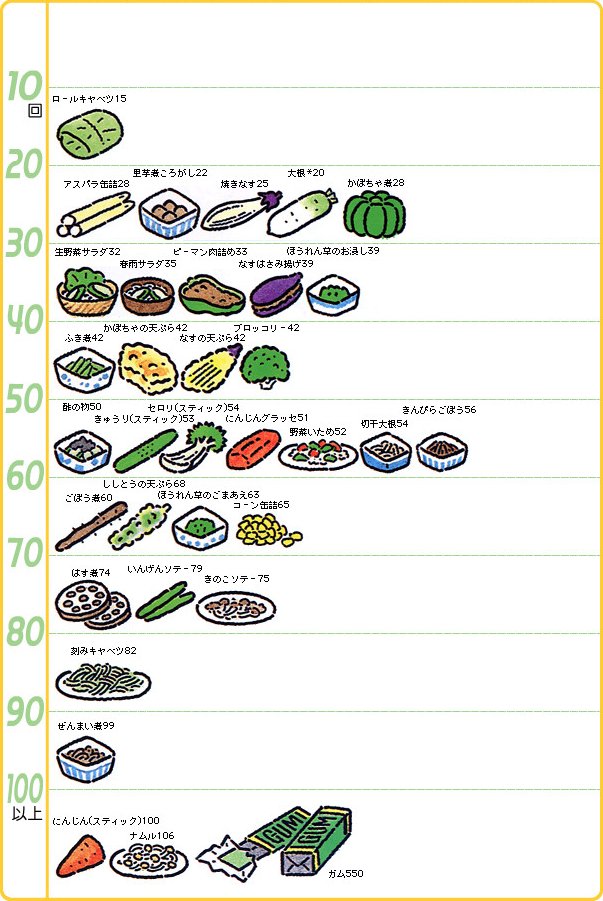


Many research institutes are conducting work to verify the effects of chewing gum,
including a recent study of 72 people, some of whom were given chewing gum and some not. As a result of analysing the levels of stress, anxiety, depression, workload and fatigue, it was found that the amount of stress experienced had decreased with the intake of gum. SMITH et al. are also conducting an intervening study to confirm the stress-reducing effect of chewing gum, with an intake of 101 people at Cardiff University for 14 days (a minimum of 2 pieces per day for 20 minutes ). As a result of a questionnaire survey relating to the feelings of stress, anxiety and degree of depression , etc., it was found that the ingestion of chewing gum reduces stress at work, as well as in our daily life in addition to helping to combat fatigue, anxiety and depression. So we can see that this point has been confirmed (2012) [2].
In addition, an intervention study on chewing gum mastication and work stress, in addition to other factors, was carried out, on 126 people. It was then confirmed that the scores for lagging and cognitive related problems were reduced significantly (2013) [3].
In addition, SMITH et al. have also conducted research on chewing gum mastication, and found that out of an observed 388 workers , which featured; ① a group that did not eat chewing gum at all, ② another group that consumed it about once a week, and ③ another, who ranged from at least five times a week, but with a maximum of once per day. As a result of a the questionnaire survey, it was found that those who often ate chewing gum had less stress in work and life, and less anxiety and depression overall (2013) [4].
In Japan, there are some examples of studies on the stress-reducing effects of chewing gum relating to subjects who chew in the work place. SAKANOSHITA et al. (2020) [5] targeted 346 department store employees 4 times a day for 6 weeks to observe if stress could be reduced. As a result of verifying the effect using the HADS scale, it was confirmed that chewing gum mastication reduces the degree of depression. In addition, SASAKI et al. (2011) [6], mentions a case using the STAI method, as well as the POMS method, where chewing gum was chewed twice a day for 5 minutes or more every day for 14 days with 50 subjects, It was confirmed that chewing gum significantly reduced anxiety, depression, tiredness, confusion, and mental fatigue compared to the control group.
Below is an example of how the chewing gum mastication stress reduction effect was verified at the laboratory level.
In a study conducted by SCHOLEY et al. (2009) [7], with 40 subjects (at an average of 21.98 years old) who were subjected to a multitasking work load using a PC and when feeling stressed, one group were asked to chew gum, whereas the other was not. We evaluated subjective stress (VAS) and cortisol in saliva (it is said that the amount of secretion increases under stress). As a result, it was found that chewing gum reduced stress levels, reduced cortisol, and improved task performance. In a study by SOEDA et al. (2012) [8], 20 healthy men were tested, and it was confirmed that chewing gum which was chewed after performing their work (an arithmetic calculation test), led to the cortisol in saliva decreasing.
Although public appearances, such as presentations are stressful, chewing gum has been proven to reduce stress. In a study by SKETCHLEY-KAYE et al. (2012) [9], when a 10-minute presentation load was applied to 36 subjects, chewing gum increased subjective arousal, while subjective anxiety decreased. It was confirmed through this that the chewing of gum is beneficial.
There has also been a study which states chewing gum reduces noise stress, and KAMIYA et al. (2010) [10] found that chewing gum mastication can reduce stress through anaylisis of when 10 subjects were subjected to noise stimulation for 20 minutes. It was evaluated by a NIRS brain measurement device. As a result, it was suggested that the nociceptive flexion reflex was suppressed and that stress was suppressed by increasing the blood serotonin (5-HT) concentration. YU et al. (2013) [11] evaluated the effect of chewing gum during noise stress loading with an FMRI measurement. Chewing gum mastication showed that (1) the activity of the superior temporal groove and the islet cortex decreased, (2) the coordination between the islet cortex and the anterior cingulate cortex decreased, and (3) By chewing gum ,the transmission from the superior temporal groove to the islet cortex was inhibited. It was suggested that the chewing gum mastication led to the stress network being blocked. KONNO et al. (2016) [12], measured 11 subjects under noise for 30 seconds, and when chewing gum was chewed, the prefrontal cortex (PFC) was activated, and α wave could be seen, the heart rate increased, the VAS was of a good score, and the STAI was of a low score. Which means chewing gum reduces stress,
Currently, research on the effect of chewing gum mastication for reducing stress is being actively conducted, and it is expected that various reports will be published in the future.
【WORKS CITED】
[1] Smith AP et al. Effects of chewing gum on the stress and work of university students. Appetite. 2012; 58: 1037-1040.
https://www.ncbi.nlm.nih.gov/pubmed/22402304
[2] Smith AP et al. Chewing gum, occupational stress, work performance and wellbeing. An intervention study. Appetite. 2012; 58: 1083-1086.
https://www.ncbi.nlm.nih.gov/pubmed/22390954
[3] Allen AP et al. Chewing gum: cognitive performance, mood, well-being, and associated physiology. Biomed Res Int. 2015; 2015: 654806.
https://www.ncbi.nlm.nih.gov/pmc/articles/PMC4449949/
[4] Smith AP. Effects of chewing gum on stress and health: a replication and investigation of dose-response. Stress Health. 2013; 29: 172-174.
https://www.ncbi.nlm.nih.gov/pubmed/22496105
[5] Sakanoshita N et al. I. Chewing gum reduces stress among department store employees. Jpn Pharmacol Ther. 2020; 48: 31-38.
http://www.pieronline.jp/content/article/0386-3603/48010/31
[6] Sasaki-Otomaru A et al. Effect of regular gum chewing on levels of anxiety, mood, and fatigue in healthy young adults. Clin Pract Epidemiol Ment Health. 2011; 7: 133-139.
https://www.ncbi.nlm.nih.gov/pubmed/21866229
[7] Scholey A et al. Chewing gum alleviates negative mood and reduces cortisol during acute laboratory psychological stress. Physiol Behav. 2009; 97: 304-312.
https://www.ncbi.nlm.nih.gov/pubmed/19268676
[8] Soeda R et al. Influence of chewing force on salivary stress markers as indicator of mental stress. J Oral Rehabil. 2012; 39: 261-269.
https://www.ncbi.nlm.nih.gov/pubmed/22040229
[9] Sketchley-Kaye K et al. Chewing gum modifies state anxiety and alertness under conditions of social stress. Nutr Neurosci. 2011; 14: 237-242.
https://www.ncbi.nlm.nih.gov/pubmed/22053754
[10] Kamiya K et al. Prolonged gum chewing evokes activation of the ventral part of prefrontal cortex and suppression of nociceptive responses: involvement of the serotonergic system. J Med Dent Sci. 2010; 57: 35-43.
https://www.jstage.jst.go.jp/article/jmds/57/1/57_570105/_article/-char/ja
[11] Yu H et al. Gum chewing inhibits the sensory processing and the propagation of stress-related information in a brain network. PLoS One. 2013; 8: e57111.
https://journals.plos.org/plosone/article?id=10.1371/journal.pone.0057111
[12] Konno M et al. Relationships between gum-chewing and stress. Adv Exp Med Biol. 2016; 876: 343-349.
https://www.ncbi.nlm.nih.gov/pubmed/26782231
Multiple studies have reported that cerebral blood flow is increased by the chewing of chewing gum (2004)[1], (1994)[2]. In these studies, chewing gum has been shown to increase carotid blood flow and oxygen uptake.
Also, there is a study that evaluated how eating chewing gum affects memory (2008) [3]. In this study, the effect of gum is evaluated by a working memory test (a test that measures short-term memory) using a device called FMRI that measures brain activity. Although the correct answer rate of the working memory test tends to decrease when chewing gum is not observed, it has been reported that chewing gum restores the correct answer rate of the test.
Furthermore, there is a study that evaluated how eating chewing gum affects attention (2013) [4]. In this study, as in the previous study, FMRI, a device which measures brain activity, is used to evaluate attention. It has been reported that chewing gum activates the attention network and improves judgment speed.
【WORKS CITED】
[1] SHIGA ET AL. THE CHANGE OF BRAIN BLOOD FLOW WHEN CHEWING CHEWING-GUM USING NIRS. JOURNAL OF JAPANESE SOCIETY FOR MASTICATORY SCIENCE AND HEALTH PROMOTION . 2004; 14(2): 68-73.
https://www.jstage.jst.go.jp/article/soshaku1991/14/2/14_2_68/_article/-char/ja/
[2] SUZUKI RT AL. EFFECTS OF GUM HARDNESS ON THE RESPONSE OF COMMON CAROTID BLOOD FLOW VOLUME, OXYGEN UPTAKE, HEART RATE AND BLOOD PRESURE TO GUM-CHEWING. JOURNAL OF JAPANESE SOCIETY FOR MASTICATORY SCIENCE AND HEALTH PROMOTION.1994; 4(1): 51-62.
https://www.jstage.jst.go.jp/article/soshaku1991/4/1/4_1_51/_article/-char/ja/
[3] YOSHIYUKI H ET AL. EFFECTS OF CHEWING IN WORKING MEMORY PROCESSING. NEUROSCIENCE LETTERS. 2008; 436(2): 189-192.
https://pubmed.ncbi.nlm.nih.gov/18403120/
[4] YOSHIYUKI ET AL. EFFECTS OF CHEWING ON COGNITIVE PROCESSING SPEED. BRAIN AND COGNITION. 2013; 81: 376-381.
https://pubmed.ncbi.nlm.nih.gov/23375117/
It has been verified and confirmed that various situations that induce drowsiness can be reversed by the chewing of gum, which banishes the effect of sleepness and in turn promotes alertness and as a sense of feeling awake.
⑴ Drowsiness when we drive a car: endo et al.(1983)[1]researched with two male drivers aged in their 20's and 30’s who had experience of driving on the highway were used as subjects.They left and drove 162km from near Tokyo and did so on the highway for approximately 3 hours between Tokyo IC and Shizuoka IC from midnight to 3:00. In the middle,they stopped at three places,the entrance of the highway and at two service areas, where they chewed chewing gum (normal gum that did not contain caffeine etc) for 5 minutes. In the control experiement,they did not chew any chewing gum when they stopped. We asked the same subject to drive twice with and without chewing gum, one week apart. The number of blinks during driving was measured to compare the difference in sleepiness with and without chewing gum. The number of blinks is known to increase with drowsiness.
Electrodes were attached to the upper and lower parts of their right eye, and potential changes observed through the blinking were measured and evaluated. When they chewed the chewing gum, the number of blinks slightly increased, but when they did not chew any chewing gum, a remarkable increase was observed from the first half of the operation, and 3 hours later, the number of blinks was about double that at the start of the operation. From the results, it was confirmed that chewing gum was shown to reduce drowsiness during driving.
(2) Arousal level during class: Nageishi et al. (1993) [2], targeting 54 students taking a psychology class at a university, chewing gum given to half of the students half an hour after the class had started and after 5 minutes of masication, a questionnaire survey using the UMACL self-report mood checklist for questionnaires showed that the students who had been chewing gum had a significantly higher energy arousal and pleasant sensation. In addition, students chewing on chewing gum were less nervous and alert and also less anxious.
(3) Arousal level during simple work: Aoki et al. (2001) [3], a test was conducted on five male university students to carry out a task regarding the addition of one-digit numbers , which was created with reference to the Uchida-Kraepelin’s work for 90 minutes in a row. Chewing gum was chewed for 2 minutes to begin with, and following this again after a space of 60 minutes, then again after 70 minutes, and finally again after 80 minutes of work, and as a result, in the electroencephalogram, the decrease in α (alpha) wave that appeared during awakening was suppressed, and the decrease in arousal level was also suppressed.In addition, by chewing gum, it was confirmed that the heart rate variability, which is the autonomic nervous system tension index, was prevented from decreasing, and that the amount of work was increased. It has been experimentally confirmed that the lowering of consciousness during simple work is suppressed by chewing gum.
⑷ Daytime sleepiness: JOHNSON et al. (2012) [4], perceived fluctuations in the pupil per unit time (PUI: PUPILLARY UNREST INDEX) with and without chewing gum when in a dark room for 11 minutes. As a result of comparing the sleepiness (SSS: STANFORD SLEEPINESS SCALE), it was confirmed that the increase in PUI and SSS was suppressed, and it was confirmed that chewing gum helped to surpress daytime slepiness.
⑸Late-night sleepiness: HODOBA et al. (1999) [5], a group of 64 students who wake up from 22:00 to 7:00 and chew chewing gum from midnight to the end of the exam ( We investigated the drowsiness of 21 people) and non-bite group (43 people) using the SSS questionnaire. As a result, it was found that chewing gum chewed reduced drowsiness, and the difference was especially noticeable when measured at between 1 am 4 am. An additional study with professionals working late at night (87 people), such as nurses or technicians , were asked to wake up late at night and walked for 15 minutes. One group consisted of gum chewers (60 people) who were requested to chew when they could not stand their sleepiness any longer. As a result of comparing the groups (along with the other 27 people who did not chew gum), it was confirmed through the SSS questionnaire. that the group who chewed chewing gum had a significantly lower and suppressed state of drowsiness. From this, it was confirmed that chewing gum can suppress drowsiness when awake late at night with or without a professional.
【WORKS CITED】
[1] ENDOU ET AL AN EXPERIMENTAL STUDY ON THE PREVENTION OF "SLEEPINESS" WHILE DRIVING A CAR. JOURNAL OF TRANSPORTATION MEDICINE. 1982; 36(3): 195-204.
https://ci.nii.ac.jp/naid/40001236389
[2] NAGEISHI. EFFECT OF CHEWING GUM ON AROUSAL IN A SELF-REPORTED PSYCHOLOGICAL TEST. JOURNAL OF JAPANESE SOCIETY FOR MASTICATORY SCIENCE AND HEALTH PROMOTION . 1993; 3 (1): 23-26.
https://www.jstage.jst.go.jp/article/soshaku1991/3/1/3_1_23/_article/-char/ja/
[3] AOKI. A STUDY OF THE CHEWING GUM EFFECTS ON THE AROUSAL LEVEL OF OPERATORS WHO ARE ENGAGED IN THE MONOTONOUS NEURO-SENSOR WORK. JOURNAL OF THE JAPANESE COUNCIL OF TRAFFIC SCIENCE 2001; 1(1): 45-51.
https://ci.nii.ac.jp/naid/10013404313
[4] JOHNSON AJ ET AL. THE EFFECT OF CHEWING GUM ON PHYSIOLOGICAL AND SELF-RATED MEASURES OF ALERTNESS AND DAYTIME SLEEPINESS. PHYSIOL BEHAV. 2012; 105(3): 815-20.
https://www.ncbi.nlm.nih.gov/pubmed/22061430
[5] HODOBA D. CHEWING CAN RELIEVE SLEEPINESS IN A NIGHT OF SLEEP DEPRIVATION. SLEEP RES ONLINE. 1999; 2(4): 101-5.
https://www.ncbi.nlm.nih.gov/pubmed/11382890
Regarding the effect of chewing gum chewing on saliva secretion, SIMONS et al. in the UK have reported research results (2002) [1]. This study compares three groups: a chlorhexidine-containing gum intake group, a xylitol gum intake group, and a control group (without chewing gum). For the two chewing gum groups, we asked them to chew two pieces for 15 minutes twice a day. As a result, it has been reported that the salivary secretion in the xylitol gum intake group is significantly higher than that in the control group.
Also, I will introduce studies on the effects of chewing gum containing eucalyptus extract on bad breath (2010) [2] and on periodontal disease (2008) [3].
When the chewing gum of eucalyptus extract was chewed 5 times a day for 12 weeks, 2 tablets per time for 5 minutes, the amount of VSC ( Abnormality of volatile sulfur compounds. Substances that cause bad breath.) has been reported to be significantly lower.
As a result of evaluating the accumulation of plaque under the same conditions, it has been reported that eating a gum containing eucalyptus extract significantly reduces the accumulation of plaque.
【WORKS CITED】
[1] DEBRA S ET AL. THE EFFECT OF MEDICATED CHEWING GUMS ON ORAL HEALTH IN FRAIL OLDER PEOPLE: A 1-YEAR CLINICAL TRIAL. J AM GERIATR SOC. 2002 AUG; 50(8): 1348-1353.
https://pubmed.ncbi.nlm.nih.gov/12164990/
[2] MUNEO T ET AL. EFFECT OF EUCALYPTUS-EXTRACT CHEWING GUM ON ORAL MALODOR: A DOUBLE-MASKED, RANDOMIZED TRIAL. J PERIODONTOL. 2010 NOV; 81(11): 1564-1571.
https://pubmed.ncbi.nlm.nih.gov/20594055/
[3] HIDEKI N ET AL. EFFECT OF EUCALYPTUS-EXTRACT CHEWING GUM ON PERIODONTAL HEALTH: A DOUBLE-MASKED, RANDOMIZED TRIAL. J PERIODONTOL. 2008 AUG; 79(8): 1378-1385.
https://pubmed.ncbi.nlm.nih.gov/18672986/
Recent studies have shown that biting chewing gum several times a day for 2 weeks to 3 months continuously improves occlusal force.
In a study of children, according to Ono et al. (1992) [1], 10 infants aged 4 to 5 years were trained to chew chewing gum twice a day for 5 minutes each for 3 months. It has been confirmed that the occlusal pressure sensor value rises from 17.6±2.55KGF at the start of training to 34.2±1.96KGF. In addition, according to Negishi et al. (2008) [2], 13 patients (9 females, 4 males, (at an average age of 10.5 years) in the mixed dentition stage (HELLMAN tooth age III B to III C) where deciduous teeth and permanent teeth grow. A chewing training with hard gum for 1 month (twice a day for 10 minutes each) was performed. It was confirmed that the maximum occlusal force and the lip closing force increased significantly before and after mastication training, and the effect was maintained 1 month after the completion of mastication training. Furthermore, according to OHIRA et al. (2012) [3], 70 kindergarten children (at an average age of 5.4 years) were given chewing gum chewing training twice a day for 5 minutes, resulting in 28 control groups (at an average age of 5.3 years). After analysing the results of an occlusal force meter measurement, of such said force along with the degree of gum colour change, due to the use of chewing gum, the trained subjects significantly improved the chewing function after 4 weeks and was still effective 4 weeks after the training.
According to MASUMOTO et al. (2009) [4], a study on adults showed that 35 healthy adults (26 males and 9 females) were given gum 3 times a day, for 10 to 15 minutes each. As a result of 4 weeks of chewing training, it was confirmed that the values of the occlusal area and occlusal force on the dental prescale increased significantly after the period. The average occlusal force before training was 1172.5±83.6N, whereas it was 1367.4±79.5N after the training period. In addition, in the study of SHIRAI et al. (2018) [5], 19 individuals with normal individual occlusion (7 male , 12 female , at an average of 25.4 ± 4.3 years old) with no stomatognathic dysfunction were administered twice daily. A 5-minute gum chewing training was performed for 4 weeks, and the maximum occlusal force was measured using an occlusal force meter. As a result, an average occlusal force increase of 22.6% was confirmed.
In a study of elderly people, NAKAGAWA et al. (2017) [6] showed that 12 community-dwelling elderly people (3 males, 9 females, an average of 77.8±4.6 years old) who did not take drugs that cause dry mouth. ), twice a day (morning and afternoon) for 5 minutes, soft gum and hard gum for 2 weeks each, with a 2-week rest period in between, and as a result, both types of chewing gum were used. In the verification, saliva at rest was significantly increased, and occlusal force by dental prescale was significantly increased. In a study by Nakazawa et al. (2018) [7], chewing gum was conducted three times a day for 30 days in 30 healthy elderly people (9 men, 75 to-89 years old, 21 women, 75 to-89 years old). As a result of chewing training, it was confirmed that the degree of color change of the chewing check gum was significantly improved.
It has been confirmed that occlusal strength is improved by the continual training of chewing gum for a certain period of time in a wide range of age groups, from infants to the elderly.
【WORKS CITED】
[1] ONO ET AL. MASTICATORY TRAINING WITH CHEWING GUM ON YOUNG CHILDREN. THE JOURNAL OF THE STOMATOLOGICAL SOCIETY. 1992; 59(2): 512-517.
https://www.jstage.jst.go.jp/article/koubyou1952/59/2/59_2_512/_article/-char/ja/
[2] NEGISHI ET AT. THE INFLUENCE OF MASTICATORY EXERCISES BY HARD CHEWING GUM UPON MASTICATORY FUNCTION OF MIXED DENTITION. ORTHOD WAVES -JPN ED 2008; 67(3): 132-138.
https://ci.nii.ac.jp/naid/110007008440
[3] OHIRA A ET AL. THE EFFECT OF CHEWING EXERCISE IN PRESCHOOL CHILDREN ON MAXIMUM BITE FORCE AND MASTICATORY PERFORMANCE. INT J PAEDIATR DENT. 2012; 22(2):146-53.
https://pubmed.ncbi.nlm.nih.gov/21781200/
[4] MASUMOTO N ET AL. DAILY CHEWING GUM EXERCISE FOR STABILIZING THE VERTICAL OCCLUSION. J ORAL REHABIL. 2009; 36(12): 857-63.
https://pubmed.ncbi.nlm.nih.gov/19845836/
[5] SHIRAI M ET AL. EFFECTS OF GUM CHEWING EXERCISE ON MAXIMUM BITE FORCE ACCORDING TO FACIAL MORPHOLOGY. CLIN EXP DENT RES. 2018; 4(2): 48–51.
https://pubmed.ncbi.nlm.nih.gov/29744215/
[6] NAKAGAWA K ET AL. EFFECTS OF GUM CHEWING EXERCISES ON SALIVA SECRETION AND OCCLUSAL FORCE IN COMMUNITY‐DWELLING ELDERLY INDIVIDUALS: A PILOT STUDY.GERIATR GERONTOL INT. 2017; 17: 48–53.
https://onlinelibrary.wiley.com/doi/full/10.1111/ggi.12670
[7] NAKAZAWA ET AL. THE INFLUENCE OF MASTICATORY EXERCISES BY HARD CHEWING GUM UPON MASTICATORY FUNCTION OF MIXED DENTITION. GERIATRIC DENTISTRY2018; 33(2): 63-69.
https://www.jstage.jst.go.jp/article/jsg/33/2/33_63/_article/-char/ja/
According to the Ministry of Health, Labor and Welfare Dental Disease Survey (1999 to-2017) [1], the proportion of children aged 10 to-14 years who had tooth decay was 69.7% in 1999, compared with 19.7 % in 2016., showing a significant decrease. On the other hand, the proportion of children aged 12 to 15 years old who are crowded (the condition in which the teeth are not aligned and overlap at several points due to the imbalance between the size of the teeth and the size of the jaws in which the teeth are lined up) The yearly increase was from 17.2% to 27.6% in 2016, one of the reasons for this reported narrowing, is the change of diet to a much softer foodbase (2010) [2].
In a report examining the effect of masticatory function on the alignment of teeth in an adult woman (2006) [3], subjects with strong occlusal force and sliding to the front, back, left, and right (grinding mastication) had a change in the tooth-growth angle, It is recognised that the width of the teeth can be widened.
There are two studies that evaluated the effect of chewing gum on the alignment of teeth in elementary school children. A chewing training was given to a child with an average age of 10.5 years twice a day for 10 minutes after chewing gum for 10 minutes, The way of chewing was changed during grinding and mastication, and also an increase in occlusal force could be observed (2008) [4]. Furthermore, when a child with an average age of 11.2 years was given the same training for 3 months, in addition to changes to grinding and mastication, it affected the way of dentition (planting of upper and lower first molars). , The width of the dentition was increased (2010) [5]. Therefore, chewing gum continuously may improve the way the child chews and may affect the allingnment of teeth .
【WORKS CITED】
[1] MINISTRY OF HEALTH、LABOUR AND WELFARE. SURVEY OF DENTAL DISEASES
https://www.mhlw.go.jp/toukei/list/62-17.html
[2] KASAI K ET AL. GROWTH CHANGE OF DENTAL ARCH FORM IN MIXED DENTITION. ORTHODONTIC WAVES-JAPANESE EDITION. 2010; 69(1): 23-35.
https://ci.nii.ac.jp/naid/110007880290
[3] HAYASHI R ET AL. RELATIONSHIP BETWEEN MASTICATORY FUNCTION, DENTAL ARCH WIDTH, AND BUCCO-LINGUAL INCLINATION OF THE FIRST MOLARS. ORTHOD. WAVES. 2006; 65: 120-126.
https://www.sciencedirect.com/science/article/abs/pii/S1344024106000665
[4] NEGISHI ET AL. THE INFLUENCE OF MASTICATORY EXERCISES BY HARD CHEWING GUM UPON MASTICATORY FUNCTION OF MIXED DENTITION. ORTHOD. WAVES-JPN. ED. 2008; 67(3): 132-138.
https://ci.nii.ac.jp/naid/110007008440
[5] NEGISHI ET AL. INFLUENCE OF MASTICATORY EXERCISES USING HARD CHEWING GUM ON CHEWING PATTERN AND FIRST MOLAR OF MIXED DENTITION. WAVES-JPN. ED. 2010; 69(3): 156-162.
https://dl.ndl.go.jp/info:ndljp/pid/10630971
Studies on biting and motor skills have been reported in children and adults. In elementary school children, the relationship between the grip strength used in the new physical fitness tests, basic exercise performance indicators, such as upper body reclining long body forward bending, repetitive side jumps and ball throwing and biting force (2011) [1] This could also be seen in young women, where it has been reported that the biting force is also related to reaction time, gripping force, and overall endurance (2018)[2].
Studies on chewing gum and improving athletic performance have also been reported by many Japanese researchers. For example, it has been reported that in university students, chewing gum 3 times a day, 2 pieces for 20 minutes for 30 days improves grip strength and performance at a section time of 50 M (2019) [3]. In addition, it has been reported that chewing gum improves the reaction rate and enhances the activity of the anterior cingulate cortex and the left frontal lobe, which are related to attention (2013) [4].
In addition, we examined the relationship between masticatory muscles and kick, spike, and shot strength using professional soccer players, volleyball players, and handball players, respectively. It has been suggested that the masticatory muscles move more strongly when the shot is released, and that the masticatory muscles may be involved in the whole body movement in sports (1994)[5],(1994)[6].
In various other sports, research is being conducted on the relationship between gum and bite force and athletic ability.
【WORKS CITED】
[1] KIBAYASHI M. THE RELATIONSHIPS AMONG CHILD’S ABILITY OF MASITICATION,DIETARY BEHAVIOR,AND PHYSICAL FITNESS,JDENT HYG. 2011; 9: 127-131.
https://onlinelibrary.wiley.com/doi/abs/10.1111/j.1601-5037.2010.00458.x
[2]ISHIYAMA. THE RELATIONSHIP BETWEEN OCCLUSAL FORCE AND PHYSICAL FITNESS IN HEALTHY YOUNG WOMEN. JOURNAL OF JAPANESE SOCIETY FOR MASTICATORY SCIENCE AND HEALTH PROMOTION. 2018; 18(1): 22-28.
https://www.jstage.jst.go.jp/article/soshaku1991/18/1/18_1_22/_article
[3] KIBAYASHI ET AL. EXAMINATION OF EFFECT OF CHEWING GUM TRAINING ON MASTICATORY ABILITY AND EXERCISE ABILITY. JOURNAL OF DIET RESEARCH.2019; 39(3): 48-57.
http://syokuken.org/39-3.html
[4] HIRANO Y ET AL. EFFECTS OF CHEWING ON COGNITIVE PROCESSING SPEED. BRAIN AND COGNITION. 2013; 81(3): 376-381.
https://www.sciencedirect.com/science/article/abs/pii/S027826261200173X
[5] OKAWA ET AL. SPORTS MEDICAL ANALYSIS ON MASTICATORY MUSCLES FUNCTION IN PROFESSIONAL SOCCER PLAYERS. THE JOURNAL OF JAPANESE SOCIETY OF STOMATOGNATHIC FUNCTION. 1994; 1(1): 165-173.
https://www.jstage.jst.go.jp/article/sgf1994/1/1/1_1_165/_article/-char/ja/
[6]] OKAWA ET AL. SPORTS MEDICAL ANALYSIS ON MASTICATORY MUSCLES FUNCTION IN VOLLEYBALL AND HANDBALL PLAYERS. THE JOURNAL OF JAPANESE SOCIETY OF STOMATOGNATHIC FUNCTION . 1994; 1(1): 33-44.
https://www.jstage.jst.go.jp/article/sgf1994/1/1/1_1_33/_article/-char/ja/
It is said that chewing and eating well is good for your health, and it has also been reported to be associated with obesity. For example, a research study of adults living in Aichi Prefecture has revealed that fast-eating people have a high BMI (BODY MASS INDEX) and a large increase in BMI from the age of 20 [1], (2006)[2].
On the other hand, gum is a food that is often chewed (2017) [3], and several studies on obesity and diet have been reported. Regsarding research relateing to diet, there was a study in which women who were obese or tended to be obese chewed gum for 10 minutes before each meal for 9 weeks continuously (2016)[4]. Weight loss, body fat percentage, and abdominal fat loss were observed in the group before and after the study.
In addition, eating healthy foods, eating slowly, and chewing gum for 15 minutes in healthy men increases meal-induced body heat production (a phenomenon in which the body heats up after eating) and burns calories. It has been concluded that it is useful for weight management (2016) [5].
In addition, chewing gum itself has been reported to increase calorie consumption, and when a healthy person sits down to chew gum, it was found that calorie consumption increased by 19% compared to just sitting alone. (1999) [6]. Furthermore, the effect of chewing gum during exercise has been reported, and it has been confirmed that when healthy adult men and women chew gum during walking, the walking speed increases, and calorie consumption and fat burning increase. 2019)[7]. Therefore, chewing gum effectively in daily life may help prevent obesity and control weight.
【WORKS CITED】
[1]MINISTRY OF HEALTH, LABOR AND WELFARE「E-HEALTH NET:RELATIONSHIP BETWEEN FAST EATING AND OBESITY- TO CHEW FOOD WELL」
https://www.e-healthnet.mhlw.go.jp/information/teeth/h-10-002.html
[2] OTSUKA R ET AL. EATING FAST LEADS TO OBESITY: FINDINGS BASED ON SELF-ADMINISTERED QUESTIONNAIRES AMONG MIDDLE-AGED JAPANESE MEN AND WOMEN. J. EPIDEMIOL. 2006; 16(3): 117-124.
https://www.jstage.jst.go.jp/article/jea/16/3/16_3_117/_article/-char/ja/
[3] SAKANOSHITA ET AL.THE NUMBER OF MASTICATION AND MASTICATION FREQUENCY OF CHEWING GUM. JOURNAL OF JAPANESE SOCIETY FOR MASTICATORY SCIENCE AND HEALTH PROMOTION. 2017; 27(1): 10-17.
https://mol.medicalonline.jp/archive/search?jo=dr3masti&ye=2017&vo=27&issue=1
[4] NOUE H ET AL. EFFECT OF ONGOING GUM CHEWING BEFORE FOOD INTAKE IN OBESE/OVERWEIGHT YOUNG ADULT JAPANESE WOMEN: A BEFORE-AFTER TRIAL. JOURNAL OF JAPANESE SOCIETY FOR MASTICATORY SCIENCE AND HEALTH PROMOTION. 2016; 26(2): 62-69.
https://mol.medicalonline.jp/archive/search?jo=dr3masti&ye=2016&vo=26&nu=2
[5] HAMADA Y ET AL. EFFECT OF POSTPRANDIAL GUM CHEWING ON DIET-INDUCED THERMOGENESIS. OBESITY. 2016; 24: 878-885.
https://pubmed.ncbi.nlm.nih.gov/26887536/
[6] LEVINE J ET AL. THE ENERGY EXPENDED IN CHEWING GUM. THE NEW ENGLAND JOURNAL OF MEDICINE. 1999; 30: 2100.
https://www.nejm.org/doi/pdf/10.1056/NEJM199912303412718
[7] KANNO S ET AL. GUM CHEWING WHILE WALKING INCREASES FAT OXIDATION AND ENERGY EXPENDITURE. J. PHYS. THER. SCI. 2019; 31: 435-439.
https://www.jstage.jst.go.jp/article/jpts/31/5/31_jpts-2018-440/_article/-char/ja
Research on increase/decrease in insulin, blood glucose, and hormones by chewing chewing gum is being conducted in Japan and overseas.
In Japan, Matsuda et al. (2002) [1] asked 19 subjects to do an overnight fast, chew gum base without sweetness and flavour for 15 minutes, and after 75 G glucose oral load (75 GOGTT). , Blood was collected at rest after 2 hours, and the amount of insulin in the blood was continuously measured. As a result, it was found that the amount of insulin at 30 minutes after 75GOGTT was significantly higher than that when chewing gum was not chewed.
Furthermore, Matsuda et al. (2006) [2] asked 19 subjects to chew sugar-containing chewing gum for 15 minutes, and similarly loaded 75 GOGTT with sugar. As a result, comparing the case of when chewing gum and not chewing gum, it has been confirmed that blood sugar and insulin rise faster and fall faster in the latter. From these two studies, it is expected that chewing gum facilitates quick insulin secretion, and also helps the blood sugar level to decrease immediately after meals, which reduces the burden on the body.
Overseas, in a study by XU et al. (2015) [3], 12 subjects were monitored with 1.4G of sugarless gum, 80 mastication movements every 2 minutes for 30 minutes after an overnight fast. GLP-1 was found to be significantly elevated by chewing gum mastication. In addition, subject satisfaction was significantly higher when chewing gum was chewed. GLP-1 is a type of hormone called "incretin" that promotes insulin secretion.
In addition, GLP-1 has the effects expected to suppress obesity, such as the effect of delaying the ingestion of food taken from the stomach and the effect of suppressing appetite. Promotion of GLP-1 secretion by chewing gum mastication was also confirmed in a study by TAKAHARA et al. (2020) [4] in Japan, and 16 adult male subjects were asked to chew a tasteless calorie chewing gum for 15 minutes. Later, it was confirmed that when 200 G of cooked rice was eaten, GLP-1 secretion was significantly increased 30 and 60 minutes after the meal compared to when chewing gum was not chewed before eating the rice. In this study, chewing gum mastication also showed a significant decrease in blood glucose immediately after eating and a significant increase in insulin secretion 15 minutes after eating.
It has also been reported that chewing gum reduces food intake, and MELANSON et al. (2017) [5] asked 33 subjects to chew twice for 20 minutes between breakfast and lunch. After that, I asked them to eat their lunch freely and confirmed that when they ate chewing gum, the amount of lunch decreased significantly.
Research has suggested that chewing gum can reduce the burden on internal organs and reduce the amount of food. It is expected that various reports will be published in the future.
【WORKS CITED】
[1] MATUDA ET AL THE EFFECTS OF MASTICATION ON INSULIN SECRETION (PART I) JOURNAL OF JAPANESE SOCIETY FOR MASTICATORY SCIENCE AND HEALTH PROMOTION.2002; 11(2): 141-145.
https://www.jstage.jst.go.jp/article/soshaku1991/11/2/11_2_141/_article/-char/ja/
[2] MATUDA ET AL THE EFFECTS OF MASTICATION ON INSULIN SECRETION (PART Ⅲ)JOURNAL OF JAPANESE SOCIETY FOR MASTICATORY SCIENCE AND HEALTH PROMOTION.. 2006; 16(2): 48-54.
https://www.jstage.jst.go.jp/article/soshaku1991/16/2/16_2_48/_article/-char/ja/
[3] XU J ET AL. THE EFFECT OF GUM CHEWING ON BLOOD GLP-1 CONCENTRATION IN FASTED, HEALTHY, NON-OBESE MEN.ENDOCRINE. 2015; 50(1): 93-98.
https://www.ncbi.nlm.nih.gov/pubmed/25758865
[4] TAKAHARA M, FUKUDA M, MATSUZAWA Y, SHIMOMURA E. EFFECT OF TASTELESS CALORIE-FREE GUM CHEWING BEFORE MEAL ON POSTPRANDIAL PLASMA GLUCOSE, INSULIN, GLUCAGON, AND GASTROINTESTINAL HORMONES IN JAPANESE MEN WITHOUT DIAGNOSED GLUCOSE METABOLISM DISORDER: A PILOT RANDOMIZED CROSSOVER TRIAL. DIABETOL INT. 2020; HTTPS://DOI.ORG/10.1007/S13340-020-00435-9
https://doi.org/10.1007/s13340-020-00435-9
[5] MELANSON KJ ET AL. CHEWING GUM DECREASES ENERGY INTAKE AT LUNCH FOLLOWING A CONTROLLED BREAKFAST. APPETITE. 2017; 118(1): 1-7.
https://www.ncbi.nlm.nih.gov/pubmed/28733151
| Production number (year on year) | Production price (year on year) | retail price (year on year) | |
|---|---|---|---|
| A.D.1989 | 36000 (107.5) | 850 (114.9) | 1210 (114.2) |
| A.D.1990 | 38000 (105.6) | 960 (112.9) | 1360 (112.4) |
| A.D.1991 | 43000 (113.2) | 1100 (114.6) | 1560 (114.7) |
| A.D.1992 | 45000 (104.7) | 1155 (105.0) | 1640 (105.1) |
| A.D.1993 | 46000 (102.2) | 1200 (103.9) | 1700 (103.7) |
| A.D.1993 | 46000 (102.2) | 1200 (103.9) | 1700 (103.7) |
| A.D.1994 | 45300 (98.5) | 1169 (97.4) | 1670 (98.2) |
| A.D.1995 | 45500 (100.4) | 1192 (102.0) | 1703 (102.0) |
| A.D.1996 | 44200 (97.1) | 1158 (97.1) | 1654(97.1) |
| A.D.1997 | 45600 (103.2) | 1205 (104.1) | 1721 (104.1) |
| A.D.1998 | 45600 (100.0) | 1213 (100. 7) | 1733 (100.7) |
| A.D.1999 | 44700 (98.0) | 1190 (98.1) | 1700 (98.1) |
| A.D.2000 | 43600 (97.5) | 1161 (97.6) | 1660 (97.6) |
| A.D.2001 | 43600 (100.0) | 1173 (101.0) | 1676 (101.0) |
| A.D.2002 | 44000 (100.9) | 1207 (102.9) | 1724 (102.9) |
| A.D.2003 | 45800 (104.1) | 1310 (108.5) | 1871 (108.5) |
| A.D.2004 | 46100 (100.7) | 1317 (100.5) | 1881 (100.5) |
| A.D.2005 | 44300 (96.1) | 1278 (97.0) | 1826 (97.1) |
| A.D.2006 | 42600 (96.2) | 1172 (97.3) | 1723 (94.4) |
| A.D.2007 | 41240 (96.8) | 1140 (97.3) | 1677 (97.3) |
| A.D.2008 | 39140 (94.9) | 1099 (96.4) | 1616 (96.4) |
| A.D.2009 | 38010 (97.1) | 1070 (97.4) | 1580 (97.8) |
| A.D.2010 | 37590 (98.9) | 1050 (98.1) | 1540 (97.5) |
| A.D.2011 | 35870 (95.4) | 982 (93.5) | 1435 (93.2) |
| A.D.2012 | 33130 (92.4) | 910 (92.7) | 1325 (92.3) |
| A.D.2013 | 30220 (91.2) | 825 (90.7) | 1220 (92.1) |
| A.D.2014 | 29020 (96.0) | 778 (94.3) | 1150 (94.3) |
| A.D.2015 | 27780 (95. 7) | 751 (96.5) | 1113 (96.8) |
| A.D.2016 | 26670 (96.0) | 715 (95.2) | 1058 (95.1) |
| A.D.2017 | 25200 (94.5) | 680 (95.1) | 1005 (95.0) |
| A.D.2018 | 24350 (96.6) | 655 (96.3) | 970 (96.5) |
| A.D.2019 | 23,300(95.7) | 630(96.2) | 930(95.9) |
| A.D.2020 | 19,000(81.5) | 510(81.0) | 755(81.2) |